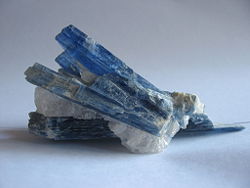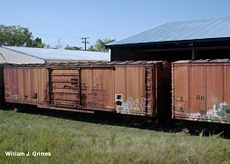Difference between revisions of "Kyanite" - New World Encyclopedia
(imported latest version of article from Wikipedia) |
(claim, fix, edits) |
||
| Line 1: | Line 1: | ||
| + | {{Claimed}} | ||
{{Infobox mineral | {{Infobox mineral | ||
| name = Kyanite | | name = Kyanite | ||
| Line 6: | Line 7: | ||
| image = Kyanite_crystals.jpg | | image = Kyanite_crystals.jpg | ||
| caption = | | caption = | ||
| − | | formula = [[ | + | | formula = [[Aluminum|Al]]<sub>2</sub>[[Silicon|Si]][[Oxygen|O]]<sub>5</sub> <br/> (aluminum silicate) |
| color = Blue; also green, white, grey, black | | color = Blue; also green, white, grey, black | ||
| habit = Columnar; fibrous | | habit = Columnar; fibrous | ||
| Line 13: | Line 14: | ||
| cleavage = [100] Perfect, [010] Imperfect | | cleavage = [100] Perfect, [010] Imperfect | ||
| fracture = Brittle | | fracture = Brittle | ||
| − | | mohs = 4.5-5 parallel to one axis <br> 6.5-7 perpendicular to that axis | + | | mohs = 4.5-5 parallel to one axis <br/> 6.5-7 perpendicular to that axis |
| luster = Vitreous; Pearly | | luster = Vitreous; Pearly | ||
| refractive = 1.71 - 1.75 | | refractive = 1.71 - 1.75 | ||
| Line 45: | Line 46: | ||
==Alternative names== | ==Alternative names== | ||
| − | Kyanite has several alternative names, including disthene, munkrudite and cyanite. White- | + | |
| + | Kyanite has several alternative names, including '''disthene''', '''munkrudite''', and '''cyanite'''. White-gray kyanite is also called '''rhaeticite'''. | ||
==Notes for identification== | ==Notes for identification== | ||
[[Image:BBBoxCar50Ft.jpg|thumb|230px|right|In [[Buckingham County, Virginia]] kyanite from the mine at [[Mt. Willis]] is transported by train on the [[Buckingham Branch Railroad]].]] | [[Image:BBBoxCar50Ft.jpg|thumb|230px|right|In [[Buckingham County, Virginia]] kyanite from the mine at [[Mt. Willis]] is transported by train on the [[Buckingham Branch Railroad]].]] | ||
| + | |||
Kyanite's elongated, columnar crystals are usually a good first indication of the mineral, as well as its color (when the specimen is blue). Associated minerals are useful as well, especially the presence of the polymorphs or staurolite, which occur frequently with kyanite. However, the most useful characteristic in identifying kyanite is its anisotropism. If one suspects a specimen to be kyanite, verifying that it has two distinctly different hardnesses on perpendicular axes is a key to identification. | Kyanite's elongated, columnar crystals are usually a good first indication of the mineral, as well as its color (when the specimen is blue). Associated minerals are useful as well, especially the presence of the polymorphs or staurolite, which occur frequently with kyanite. However, the most useful characteristic in identifying kyanite is its anisotropism. If one suspects a specimen to be kyanite, verifying that it has two distinctly different hardnesses on perpendicular axes is a key to identification. | ||
==References== | ==References== | ||
| + | |||
*[http://webmineral.com/data/Kyanite.shtml WebMineral Listing] | *[http://webmineral.com/data/Kyanite.shtml WebMineral Listing] | ||
*[http://www.mindat.org/min-2303.html MinDat Listing] | *[http://www.mindat.org/min-2303.html MinDat Listing] | ||
*[http://mineral.galleries.com/minerals/silicate/kyanite/kyanite.htm Mineral Galleries] | *[http://mineral.galleries.com/minerals/silicate/kyanite/kyanite.htm Mineral Galleries] | ||
| − | [[Category: | + | [[Category:Physical sciences]] |
| − | [[Category: | + | [[Category:Earth sciences]] |
| − | [[Category: | + | [[Category:Geology]] |
| + | [[Category:Minerals]] | ||
| − | + | {{credit|130207832}} | |
| − | |||
| − | |||
| − | |||
| − | |||
| − | |||
| − | |||
| − | |||
| − | |||
| − | |||
| − | |||
| − | |||
| − | |||
| − | |||
| − | |||
Revision as of 22:14, 15 May 2007
| Kyanite | |
|---|---|
 |
|
| General | |
| Category | Mineral |
| Chemical formula | Al2SiO5 (aluminum silicate) |
| Identification | |
| {{{molweight}}} | |
| Color | Blue; also green, white, grey, black |
| Crystal habit | Columnar; fibrous |
| Crystal system | Triclinic |
| Cleavage | [100] Perfect, [010] Imperfect |
| Fracture | Brittle |
| Mohs Scale hardness | 4.5-5 parallel to one axis 6.5-7 perpendicular to that axis |
| Luster | Vitreous; Pearly |
| Refractive index | 1.71 - 1.75 |
| Pleochroism | Trichroic, colorless to pale blue to blue |
| Streak | White |
| Specific gravity | 3.56 - 3.67 |
| {{{density}}} | |
| Solubility | None |
| Diaphaneity | Transparent to translucent |
Kyanite, whose name derives from the Greek word kyanos, meaning blue, is a typically blue silicate mineral, commonly found in aluminium-rich metamorphic pegmatites and/or sedimentary rock. Kyanite is a diagnostic mineral of the Blueschist Facies of metamorphic rocks.
Kyanite is a member of the aluminosilicate series, which includes the polymorph andalusite and the polymorph sillimanite. Kyanite is strongly anisotropic, in that its hardness varies depending on its crystallographic direction. While this is a feature of almost all minerals, in kyanite this anisotropism can be considered an identifying characteristic.
Uses of kyanite
Kyanite is used primarily in refractory and ceramic products, including porcelain plumbing fixtures and dinnerware. It is also used in electrical insulators and abrasives. An interesting property of kyanite is that it undergoes an irreversible expansion when fired at high temperature.[citation needed] Kyanite has also been used as a gemstone, though this use is limited by its anisotropism and perfect cleavage. Finally, as with most minerals, kyanite is a collector's mineral.
Associated minerals
Kyanite is usually found in association with its polymorphs, as well as other silicate minerals. These include:
- andalusite, Al2SiO5
- sillimanite, Al2SiO5
- quartz, SiO2
- staurolite, Fe2Al9Si4O22(OH)2
- micas, AB2-3(X, Si)4O10(O,F,OH)2
- garnets, A3B2(SiO4)3
Alternative names
Kyanite has several alternative names, including disthene, munkrudite, and cyanite. White-gray kyanite is also called rhaeticite.
Notes for identification
Kyanite's elongated, columnar crystals are usually a good first indication of the mineral, as well as its color (when the specimen is blue). Associated minerals are useful as well, especially the presence of the polymorphs or staurolite, which occur frequently with kyanite. However, the most useful characteristic in identifying kyanite is its anisotropism. If one suspects a specimen to be kyanite, verifying that it has two distinctly different hardnesses on perpendicular axes is a key to identification.
ReferencesISBN links support NWE through referral fees
Credits
New World Encyclopedia writers and editors rewrote and completed the Wikipedia article in accordance with New World Encyclopedia standards. This article abides by terms of the Creative Commons CC-by-sa 3.0 License (CC-by-sa), which may be used and disseminated with proper attribution. Credit is due under the terms of this license that can reference both the New World Encyclopedia contributors and the selfless volunteer contributors of the Wikimedia Foundation. To cite this article click here for a list of acceptable citing formats.The history of earlier contributions by wikipedians is accessible to researchers here:
The history of this article since it was imported to New World Encyclopedia:
Note: Some restrictions may apply to use of individual images which are separately licensed.
